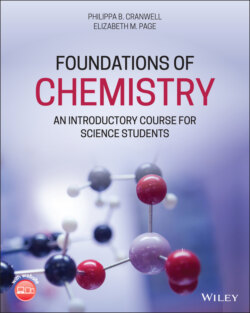Читать книгу Foundations of Chemistry - Philippa B. Cranwell - Страница 132
End‐of‐chapter questions
Оглавление1 Draw a dot‐and‐cross diagram to show the bonding present in a molecule of nitrogen, N2.
2 Explain the difference between ionic, covalent, and metallic bonding, giving an example of each type of bonding.
3 State the most likely type of bonding present in the following species:The term ‘species’ is used to represent a compound such as a molecular substance or an ionic material or a metal.AluminiumNaClFormaldehyde, CH2OMgBr2Bronze (an alloy of copper and tin)Ethyne, C2H2Borane, BH3
4 Draw the bonding present in the following species:StrontiumCaCl2Formaldehyde, CH2OAlCl3Ethyne, C2H2Borane, BH3NiCl2
5 Determine whether the following species contain a permanent dipole:Ethyne, C2H2Ethane, C2H6AlCl3CO2CH3OH1,3‐difluorobenzene1,4‐difluorobenzene
6 List the most likely intermolecular forces that exist in each of the following compounds. There may be more than one type of intermolecular force in each molecule.Ammonia, NH3Iodine, I2Formaldehyde, CH2OEthanoic acid, CH3COOHMethane, CH4Silane, SiH4
7 Draw the hydrogen bonding between the following molecules:Ammonia, NH3 and methanol (CH3OH)Ethanoic acid (CH3COOH) and waterTwo hydrogen fluoride, HF, molecules
8 Suggest the shapes of the following molecules:BF3CHCl3PCl3H2SBeCl2
